|
I make sculpture because I love the physical process of making
sculpture. It's an experience that's hard to explain.
When you weld or cut, you have total concentration on this small
area. Feeling the metal forming into something is a great experience.
It's a sort of alchemy.
FIRST SLIDE: Images of Studio


This is my studio. It's not the normal image of a studio.
It's a concrete slab 16-foot by 8-foot at the rear of my garage.
It's open to the air, which means I cannot work when it's wet
or too cold or too hot, but I also don't have to breath the garbage
put out by my welding machine.
It's a great place to work. All the tools are stored in the garage,
and I have very tolerant neighbors.
As you can see, I work until I have no more space, and then I
move out the sculptures. Oddly I call the sculptures finished
at this stage, and date them at that point, although it may take
another year of rusting before I can put a finish on them.
The finish is Minwax Antiquing Oil, which interestingly is also
the finish used on the inside of Frank Lloyd Wright's Pope-Leighey
House. It's basically linseed oil in a highly volatile solvent.
It just retards the rusting of the steel, but even without the
oil, there is minimal rusting on the sculptures, after the initial
patina.
When I was studying architecture, I had a recurring nightmare.
I was always building. Architecture is very non-physical. It draws
a distinction between design and labor. I don't make that distinction.
The physicality of making is essential for me. I both design and
make my own work. But my architecture training means that I separate
the processes.

My first style is very much tied to my training in architecture.
I design and then I fabricate. 'PYRAMID, INVERSION' is a classic
example. For the minimal forms, there is no other way to do them.
I do work using proportions, but always break the pattern. Perfect
proportions make very predictable art. Breaking proportions gives
a sense of hand.
The second style is totally free. I make a basic form or frame,
and then add components intuitively. 'HAUS TAMBARAN' is an example.
I find that there is a certain point where drawing and planning
must stop, and I must start a sculpture. If I overdraw a piece,
it becomes totally stale, and I loose interest in making it.

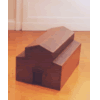
I work in both styles - usually back to back. I will do something
like 'ROMANESQUE INTERNAL', which is very open, and then do something
totally minimal, like 'ROMANESQUE EXTERNAL'. My favorite place
is somewhere in the middle. A Walk in a Dogon Village is an example.
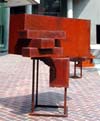
I rarely use maquettes. FallingWater was a very hard piece to
conceive. The first try did not work, because it was too small,
and I chickened out. I then made a rough 1/2 scale maquette, before
doing the final piece.
But even then, things do change during fabrication.
The top of Fallingwater was very planned; the base was freeform
on a frame.
So, this is the way I work: a blend of intellectual enquiry, and
physical labor. The enquiry is more subject-oriented, the labor
is object-oriented. As these blend, my understanding of both increases,
and that is very stimulating. There are of course inherent inconsistencies,
but the really important thing is that it all stimulates me to
make sculpture, and that is what really matters.
So where do I get my ideas for sculptures?
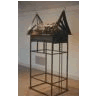 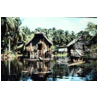
I visited the Sepik River in 1982. The sculptures were born in
1990. It took 8 years for me to translate the subject into an
object.
The thing that I observed about these sculptures was that people
actually looked at them. They noticed them because they looked
like something they thought they knew ( houses - bird houses ),
and yet they knew they weren't that. So their curiosity was peaked.
People rarely approach minimal art in that manner because there
is no process of discovery.
I call this the subject / object dichotomy.
A sculpture is the thing you fall over when you step back from
the wall to look at a painting. So a sculpture is a thing. It
is an object. But this object must be about something. It has
a subject.
The battle of whether we perceive a sculpture as an object or
a subject is what interests me.
I remember once I was in the art gallery in Sydney with my mother
and my 2-year old nephew, Abe. Mum and I were looking at the paintings
on the wall, trying to avoid falling over a sculpture on the floor.
Suddenly we realized that we had lost Abe. We looked down, and
there he was wrestling with a bronze relief sculpture of a figure
on the floor.
What we had been trying to avoid falling over, he had squarely
faced.
What, for us, was an object to avoid, was for him a subject to
be addressed.
So, what is one man's subject is another man's object.
So, in my work, I play with subject / object and the way that
it will challenge people. The work is an enticement to explore,
as opposed to a fait complete. I really get great delight at the
excitement of someone who looks at one of my sculptures, and comes
up to me and says, for example, "That's a Kiva. I know what it
is. I just came back from the South-West".
The trick is to find the essence of the subject. Too little distillation
of the image will trivialize the topic. Too much introspection,
and will result in a sculpture that is more research that art.
That's the trap, and why I love playing with subject / object.
The time to physically make a sculpture is minimal compared to
the time it takes to catch the essence.
----
These sculptures are based on New Guinea houses. They are in fact
based on New Guinea houses seen when I was in the Sepik River
in 1982. It represents a personal experience of seeing the houses.
Why? Because when I was in New Guinea in 1982, there were massive
floods, and houses normally 2 miles from the river, were now over
the water. Therefore the stilt nature of the houses was accentuated.
Had I been there 2 weeks earlier, or 2 weeks, later the image
would have been very different. It is the uniqueness of the subject
that creates the form of the object.

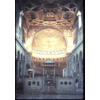
Next pair: 'ROMANESQUE, INTERNAL' / San Clemente or Santa Praessede
The concept actually came from a book by Edward Tufte about the
visual representation of statistical data, and how to display
the most amount of information in the smallest space. It's also
a reaction against one of his comments.
Tufte states that you can't run a narrative in art without it
becoming trivial. There is a strong tradition of narrative art,
from Etruscan, through Romans, through Giotto. And none of this
is trivial. The eye does not perceive any image in toto. It actually
creates its own narrative path within an object, and the process
of looking at any object is in itself a narrative.
'ROMANESQUE, INTERNAL' was the first narrative piece that I did,
and was originally intended to be more complex. It is based on
San Clemente in Rome, which is a church built on top of two previous
churches, and a Mithraian altar.
This concept of layering was used in "A Walk in a Dogon Village",
which is the most recent and strongest of my narrative pieces.
Even the title is a narrative.
So, how did I become a storyteller? In one word: travel.
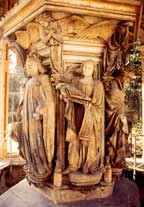

Next: WELL OF MOSES (1395 - 1399) / CONQUES (1125-1150)
These are the best pieces of sculpture that I've seen, and neither
was the destination of the journey.
I went to Dijon to see the tombs of the dukes of Burgundy, and
saw this piece by the same sculptor, Claus Sluter. It is the well
of Moses. It shows how a complex image can have the same consistency
and resolution as a minimal sculpture, without using all the standard
mathematical tricks.
I went to Conques to see the Reliquary of St Foyes. This is what
I found.
It is the tympanum of the church of St Foyes. It is a beautiful
flowing narrative. However, its context is incorrect. Originally
it would have been inside the church. That's the trap of believing
what you see.
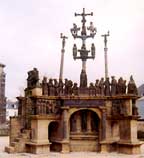 |
 |
NEXT: CALVARIES (Plougastel- Daoulas 1601 - 1604 ) / St. Uzec.
The next two pieces are from Brittany in France. Both are Calvaries,
as is the Well of Moses. They are pure narratives.
One is subject. One is object. The one on the right is a Christianized
Menhir, so it was done in two different periods. What I find interesting
about these, is that they both tell the same story, but the one
of the right actually tells more. However you need to know the
story, to get all of the information from it. Note the stairway
on the first piece. This is so that, at Easter, the priest can
actually point and narrate the story.
So, why the interest in religious art. Well, when you stop being
a minimalist, and design is no-longer a justification for art,
you really need to look closely at the purpose of art. Religion
has been a great subject for art.
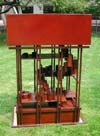
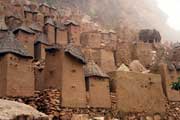
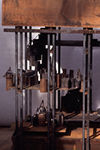
Let's talk about this sculpture. This is the most narrative piece
I've done, and doubt I will ever be this literal again, at least
not consciously. Narrative is now part of my artist vocabulary,
and it's hard not to use the words you know.
When you visit the proverbial Dogon village, you walk out from
the hotel across the cliff tops.
And then you descend through a passage in the cliffs, and see
the village emerging below you. You snake down through the village,
and finally reach the bottom and plateau. At the bottom are Fulani
herdsmen watering their cattle.
So you have that sense of spiraling down to the village. The essence
is of spiraling-down narrative. This is what I was aiming at in
the work.
The source is related to a narrative at a certain time. If it
had been wet, the experience would have been different. It would
be a different narrative. If I had walked up from the plain below
the village, it would be a different impression.
In discovering anything, there are two perception points that
matter. There is the initial gut feel to the piece, and the discovery
that we take as we explore the subject, this is a narrative.

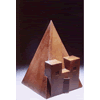
The slides show two sculptures of basically similar subject. Both
are pyramids.
Pyramid inversion was based on a lot of reading, and visiting
Egyptian structures (none unfortunately in Egypt ). The inversion
is because when we think of pyramids, our concept is of the external
form, but this is not the important thing.
The reason for the pyramid is the burial chamber within it. At
the risk of laboring the point, the pyramid is the object, the
chamber is the subject. What the sculpture does is to make the
most important thing visible. It inverts that normal way of looking
at the pyramid, by inverting the scale.
Pyramid Meroe, was based on an image in a book. Very little research
was done, because very little information was available. It works
as a sculpture, but the image is actually totally incorrect. The
first image that I saw in a book was misleading, as the towers
are in reality on a temple in front of the pyramid. The image
was wrong, but the visual image was so strong that I used it.
So, I used the incorrect image, and the sculpture is incorrect.
Incidentally the sides of the pyramid are 72 degrees, which is
the golden mean angle. This is a coincidence, as I do not use
magical numbers in my sculpture. I believe these do not work.
Since being correct, and being incorrect, don't seem to make much
difference, does it really matter.
I believe it does. If the sculpture is true to its subject as
the viewer knowledge of the subject increases, they see how it
relates to the sculpture, and the sculpture forces them to explore
the subject more. There is a parallel discovery of sculpture and
subject.
If the sculpture is untrue to the subject, it is a purely visual
phenomenon, and the purely visual does not keep our interest or
attention.


As an example, lets look at one of the Wright Series.
This is my favorite price in the show. Apart from being one of
the few pieces, which I can easily carry by myself, it really
works.
It has lovely subject / object dichotomy. The screw head plays
very well with this dichotomy, because it totally destroys any
reference to scale in the piece. It is hard to determine without
external sources, if the screw is large, of if the sculpture is
small.
There is also a reference in the piece to Frank Lloyd Wright's
childhood. As a child he used toys invented by Froebel, the inventor
of Kindergarten. These toys appear in the American marketplace
as Lincoln logs, invented by John Lloyd Wright, his son.
It catches the curiosity. There is even a hidden secret in the
piece.
This sculpture is also great because it has stimulated enquiry.
I spoke to someone who, since seeing the show, has been to the
Pope-Leighey House (its subject), Monticello, has planned a trip
to FallingWater, and is thinking of visiting Chicago. That makes
the piece a success.
That's what I want to do in my work. Make people think, by breaking
preconceptions.
I also find that making sculpture, and having to explain my work,
also makes me discover sources and ideas that I would never realize.
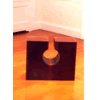
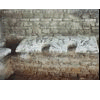
But even humor can educate. This piece is based on the form of
a public toilet in Ostia Antiqua, Rome.
So, does all of this intellectualizing about my work really matter.
Well it explains sources and the subject, and hopefully will make
you look more thoroughly at my work and other sculpture. Or even
look differently at the work of FLW.
The problem with any exhibition is that it has a finite exposure,
so people get a limited time to look at the work. I used to collect
art, and one thing about living with art, is that you realize
what sustains attention.
Good art grows on you. It's like a relationship or a good wine.
It matures with ages, and new nuances appear.
After the show, some of the pieces will be going to the residence
of the Australian Ambassador, where they will have a completely
different audience. This is the ideal venue for the work, because
they really are personal pieces meant for a domestic environment.
So, making sculpture for me, is a great way to explore visual
ideas. It really puts ideas to the test.
If you want to find out more, you are welcome ask me questions
now, or in the garden. There is a lot of information on my website,
www.ozmetalman.com, and you can even email me with queries.
I'm always happy to answer questions because often I learn as
much from your questions, as you'll learn from my answers.
John Mors
|